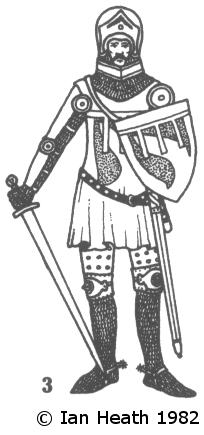
Try Amazon Audible Plus
SIR HUGH HASTINGS 1347
An extract from Armies of the Middle Ages, Volume 1by Ian Heath



3. SIR HUGH HASTINGS 1347
From the celebrated Hastings brass at Elsing in Norfolk, this figure and the next portray knightly equipment as worn at the time of Crécy.
The surcoat has again changed in style, being now short and full, but it should be noted that the older styles also remained in limited use. Sir John Chandos, for example, appears to have worn a long, flowing surcoat similar to that of figure 1 when he was killed at Lussac Bridge. Generally, however, such long surcoats had disappeared by this time, and the style depicted here remained fashionable throughout the 1340s and 1350s.
Sir Hugh’s arm-harness remains much the same as Fitzralph’s, though interestingly the besagew guarding his left armpit is now bigger than that worn on the right, a trend which was to continue after the general abandonment of the shield (see note 11). In fact this is a late appearance by besagews, which were rare after c. 1335 and are in fact not worn by several of the figures on this brass. Hastings’ besagews are described in a source of 1408 as being buckled to the underlying mail, as is the deep bevor - a comparatively rare piece of armour at this date - protecting his throat. On his thighs are cuisses of brigandine construction, the gilt-headed rivets securing small metal plates between a fabric cover and a leather foundation, while his knees are protected by poleyns mounted on broad bands of cuir-bouilli. Rivetted cuisses became more and more common as the mid-14th century approached.
The earlier helm has now been replaced by the visored bascinet, the visor of which was hinged either at the sides as here or on the forehead and could be removed if unwanted. The bascinet itself still retains its somewhat globular shape, though that of figure 4 displays the more characteristic tall, pointed profile that was to predominate hereafter. The visor extension, however, occurs only during the period 1330-60. Helmets generally had padded linings (Henry V’s retinue at Agincourt included a ‘stuffer of bacynets’, for example), or were worn over a variety of padded headwear that resembled a Phrygian cap in its shape. Others still wore arming caps (coiffes de toile) of the type described under 6a in Armies of Feudal Europe.
[Based on The Brass of Hugh Hastings, c.1340, St Mary the Virgin, Elsing, Norfolk, England.]